Oct 13, 2022
(except where noted, the photos are mine)
TOLEDO
From September 19 to October 6 my husband Joe and I traveled in Spain, an early celebration of our 23rd anniversary. We began in Toledo. The taxi from the train station drove us up and around and around cobblestone streets barely able to accommodate one car, to deposit us at our hotel in the old city.
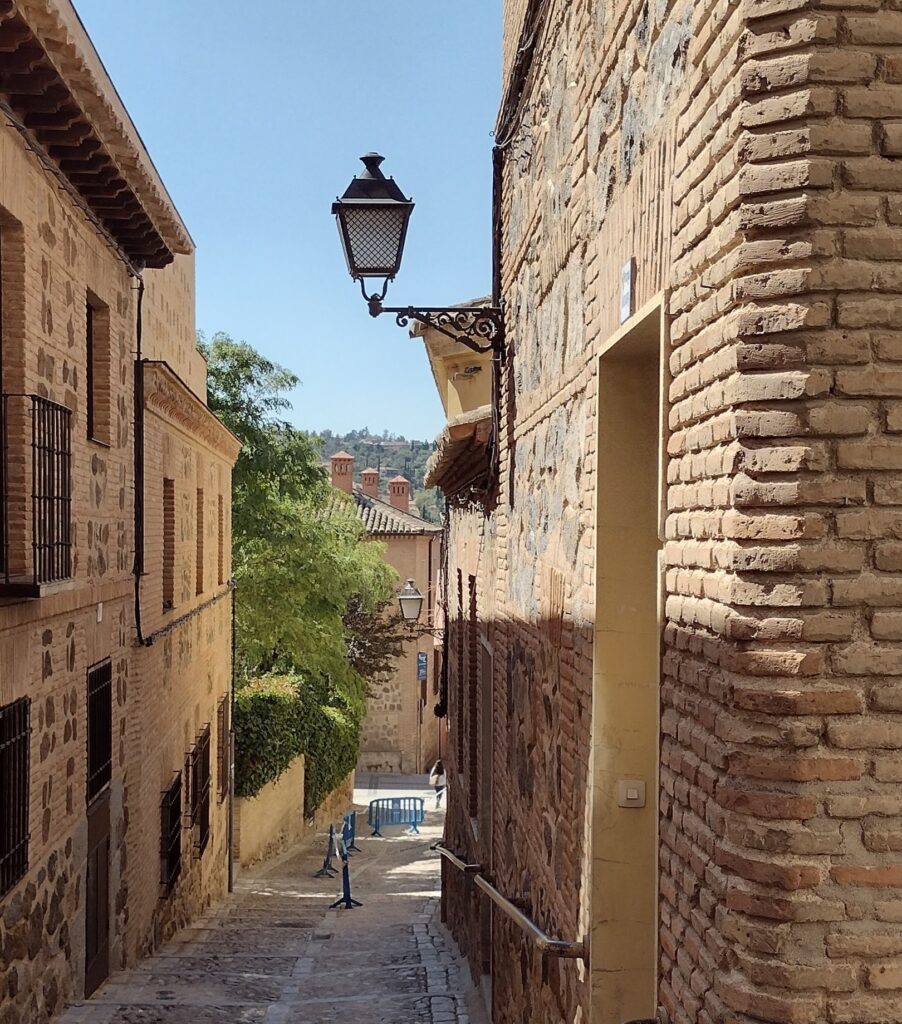
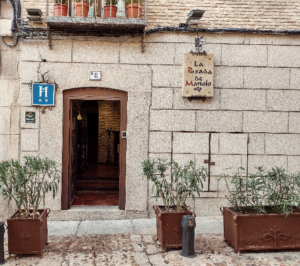
The next morning we climbed three flights of stairs to the rooftop breakfast terrace, passing the native koalas on the way. Breakfast was pastries, toast, lots of fresh fruit, serrano ham and cheese, excellent strong coffee.

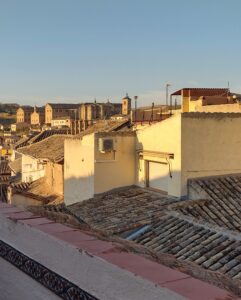
For three days we walked and walked – in the medieval streets and across the Rio Tajo. Here are pictures from the river walk.

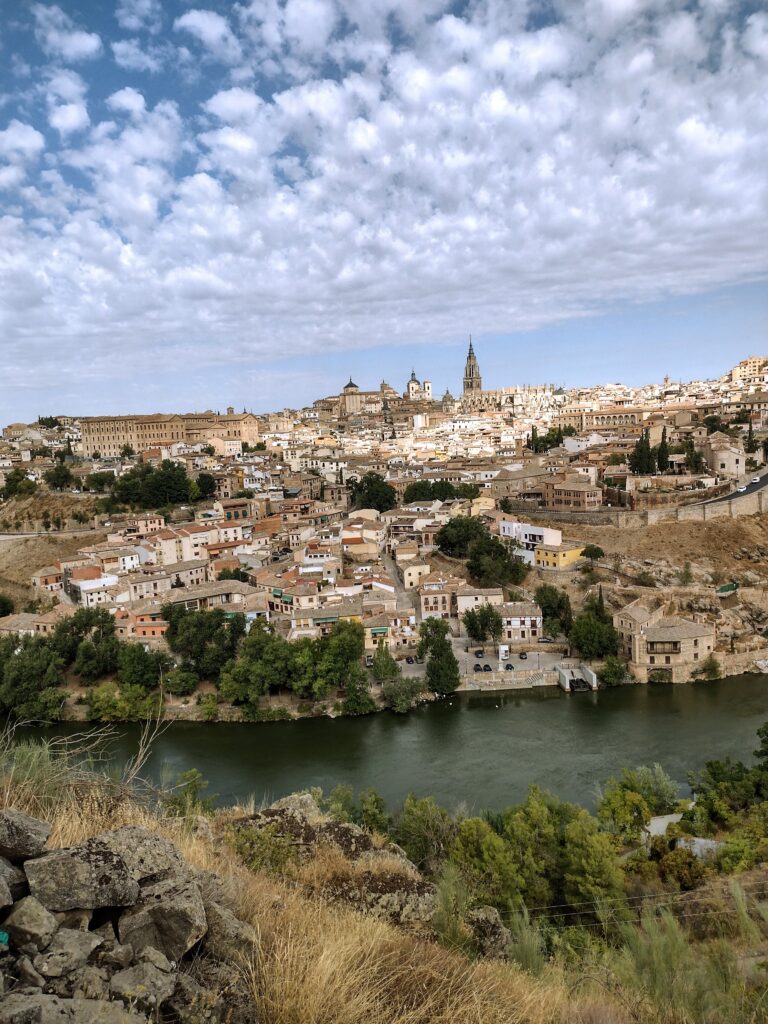

Toledo is a miracle of physics – all the walking is uphill. It was a tough workout, but good preparation for the rest of Spain. It is a welcoming town, unless you’re an asshole.

“Smile, God loves you”

“If you’re a racist, xenophobe, homophobe, or rude, don’t come in.”
AVILA
Avila is famed for its medieval wall, which has not succumbed to time but still encircles the old city. We walked on it during the day, and walked around it at night, when it’s illuminated.
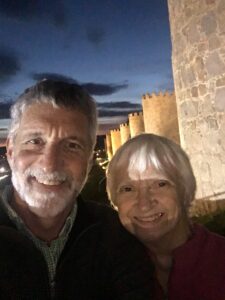 (image by Joe)
(image by Joe)
The streets are steep, but not as narrow as in Toledo.
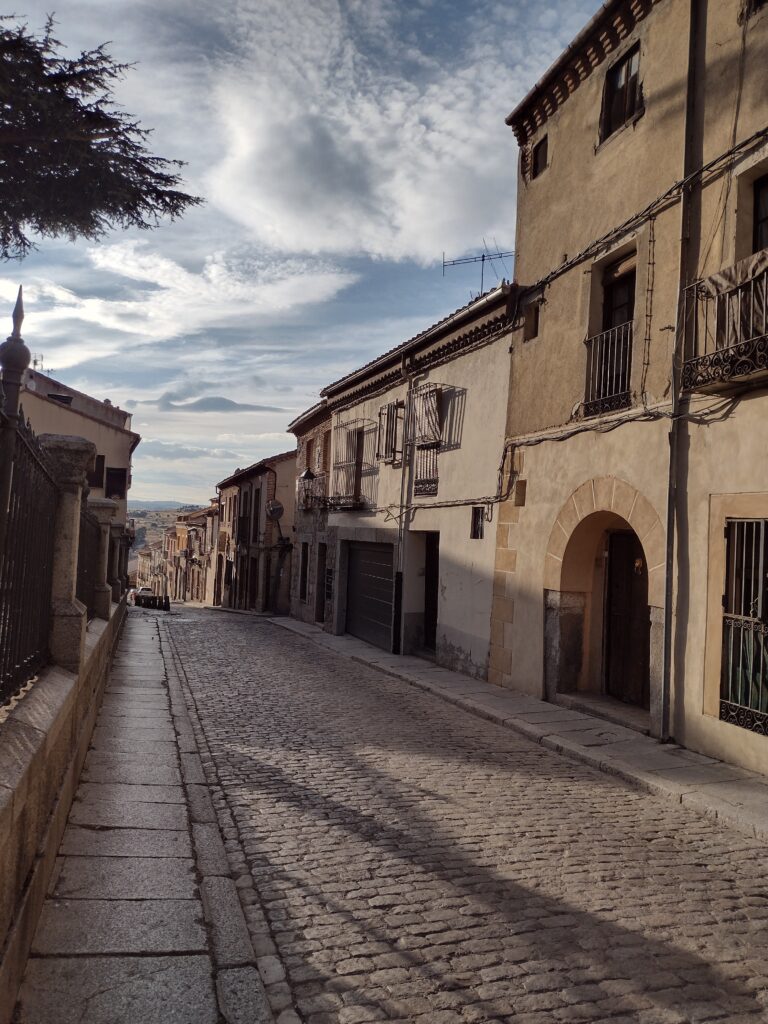
We were there on a weekend, and the people-watching was as good as any of the official sights – large families including infants and great-grandparents strolled the streets, sat in cafes, ate long Sunday dinners in courtyard restaurants. And everybody (except me) had a dog.
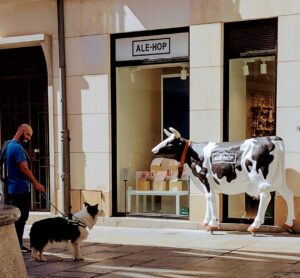
I went outside the old city and downhill to the Real Monasterio de Santo Tomas. It was lovely, but its beauty is stained by its history. It was the headquarters of the Spanish Inquisition.

On the way I noticed a shoe repair shop. Joe had his broken hiking boot repaired there and met a friendly cobbler. The poster was a bonus.

It offers the suffering feet relief from bad smells and excessive sweat
We took a side-trip to Salamanca where we visited the Catedral Vieja. The extravagant interior of the Toledo Cathedral, built for the glory of God (or archbishops) had sickened me, but I hadn’t given up on cathedrals yet. I liked these ungilded (and beheaded) images.



BURGOS
By now I avoided entering cathedrals, but the exteriors continued to fascinate me. Here are figures on a fountain outside the Burgos Cathedral. (In case you can’t tell, this two-tailed mermaid symbolized lust. I don’t know what the guys riding the beasts symbolize, but I love their faces.)
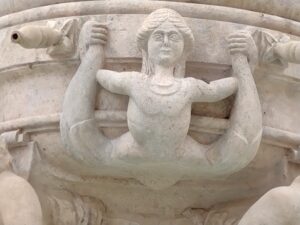


These scribes above a Cathedral door looked mighty female to me, and I took it as a blessing for my writing:

We left Burgos heading to El Castillo, where we had a cave tour at noon, but first Joe had a surprise for me. We drove to El Colegio do San Pedro de Cervatos, a 12th century church in a tiny village. Most of the ornament was high up under the roof. The surprise? A sheela-na -gig. Joe knows how I love these, and how they are connected to my late sister Luli. It was not on a cornerstone as in Ireland, but it sure was a sheela! I was overwhelmed; I would have given anything (except Joe) to have Luli there.


(for more about Sheela-na-gigs, see https://elizabethmccullochauthor.com/the-real-celtic-woman/
EL CASTILLO
El Castillo has the oldest cave paintings in the world; one is over 40,000 years old. We were the only people on the tour, with a very enthusiastic guide. No photos allowed, so I’ve borrowed some. FYI: “A 2013 study of finger length ratios in Upper Paleolithic hand stencils found in France and Spain determined that the majority were of female hands, overturning the previous widely held belief that this art form was primarily a male activity.” (Wikipedia)

 (images from pinterest.com)
(images from pinterest.com)
After El Castillo we headed to Ribadesella on the Bay of Biscay, where there was another cave, as well as great seafood meals in cider bars. (I ate cockles and limpets.) We had our fanciest hotel there, with a sit-able balcony looking over the Bay – not good enough for Joe, who went swimming for about half an hour in the icy water.
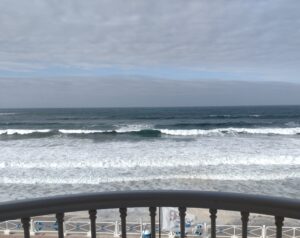
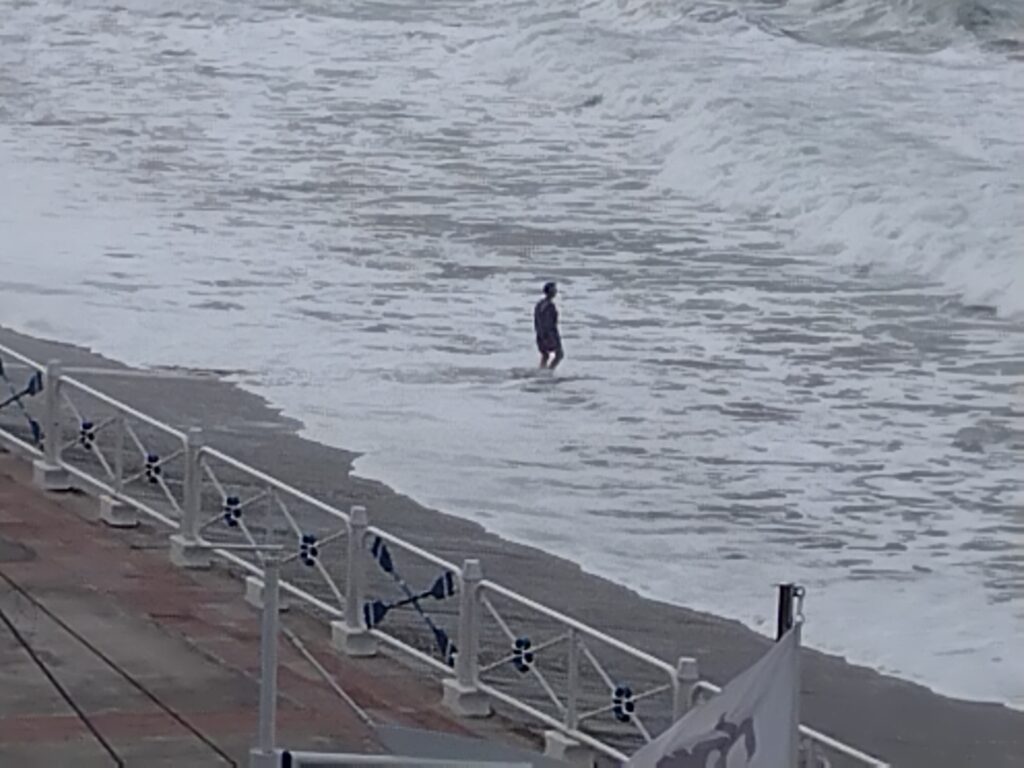
The long walk through the Cave of Tito Bustillo, with precarious footing and another great guide, was full of wonderful drawings.

(image from pinterest.com)
After the cave, we headed for a hike in a recreation area in Pesanca; Joe negotiated one-lane rural mountain roads while I enjoyed the scenery. We only got lost a couple of times.
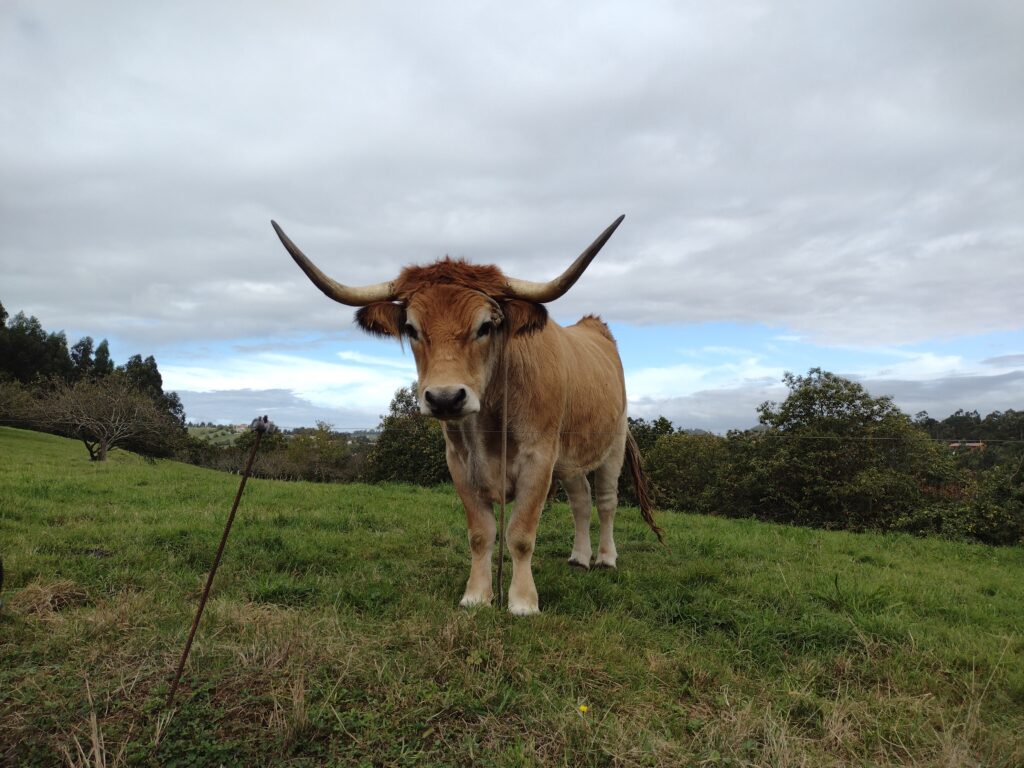
After a drizzly uphill walk by a creek, on our way back to Ribadesella we went to Bufones de Pria, where giant waves crash up and over high cliffs, and misty geysers rise up among the rocks where you’re walking.
 (image pinterest.es)
(image pinterest.es)
Weather changed our plans for a canoe run and a hike around a mountain lake, so we spent a night in Oviedo to break the long drive to Santiago de Compostela. In Oviedo I met Mafalda, an old Argentine friend of my family.

The next day’s drive was full of surprises and astounding sights and more remote one-lane roads. There was a bakery in a tiny town lauded for the best pastry in Spain, and the Cathedral Beach, where the ocean has carved out huge arches from the cliffs. No pictures of these, alas. But my favorite stop was El Castro de Coana, a pre-Roman fortified village, which dates back to the 4th century BCE.
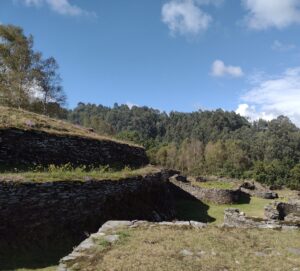


Cabo Ortegal is the north west-est tip of Spain, where the Cantabrian Sea meets the Atlantic Ocean. Looking across into the beginning of sunset I thought I could see Canada, but checking latitudes at home I discovered it would have been closer to Portland, Maine.
 (image pinterest.es)
(image pinterest.es)
We arrived in Santiago fairly late and very tired. The next day we did laundry while Joe toured yet another cathedral and I sat in a café people-watching. (24/7 togetherness is a bit much, even on an anniversary trip.)
I wandered alone in Alameda Park overlooking the town and the university. I encountered many friendly old people on their morning constitutionals, including a Santiago native who had worked for Iberia Airlines in Miami and a couple who took my picture with a statue of Isaac Diaz Pardo – a prominent ceramicist and promoter of Galician culture. There is a church in the park, Igrexa de Santa Susana. I admired these angels, above the front door of an elementary school named for Susana.
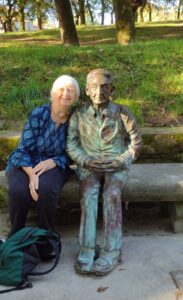
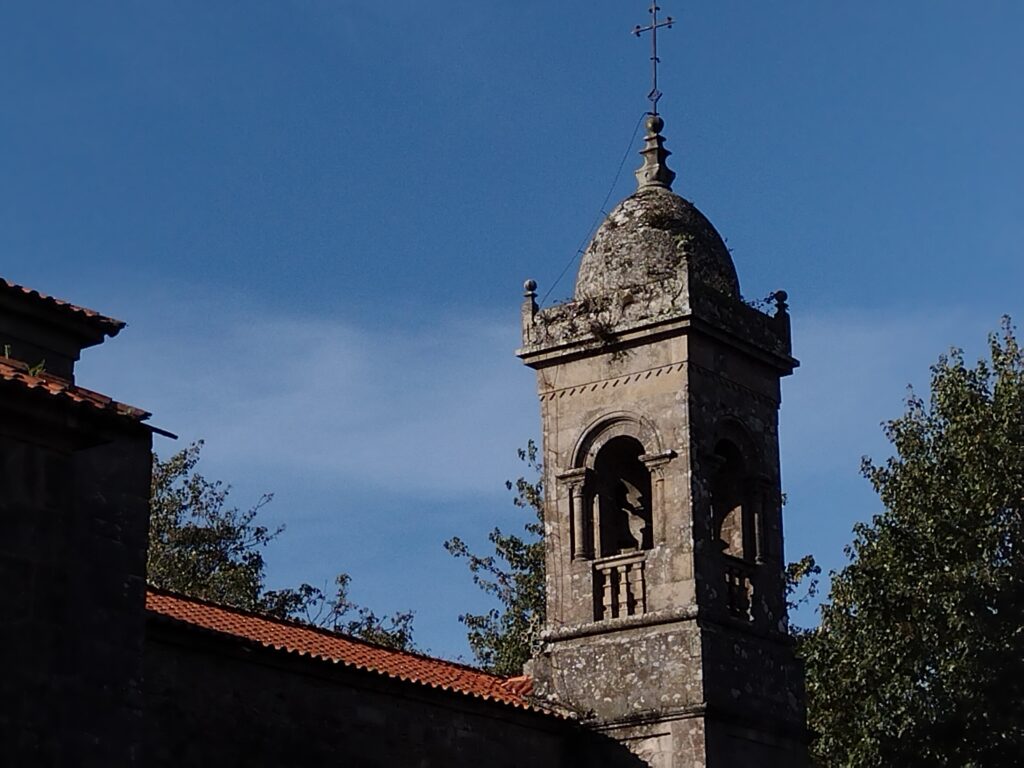

MADRID
As we drove into Madrid I had an attack of urban phobia – nasty traffic, zillions of people, huge buildings. But I adjusted, and soon enjoyed the energy (and the food, and Joe). I spent one morning wandering and ended at the gardens by the Royal Palace. I was writing in my sadly-neglected travel diary when I heard a band. It was the monthly parade in front of the palace. A large crowd waited (and waited) and a young woman escorting her grandmother urged me into her prime viewing spot.
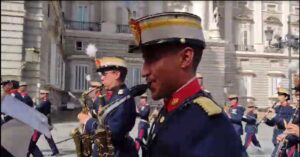
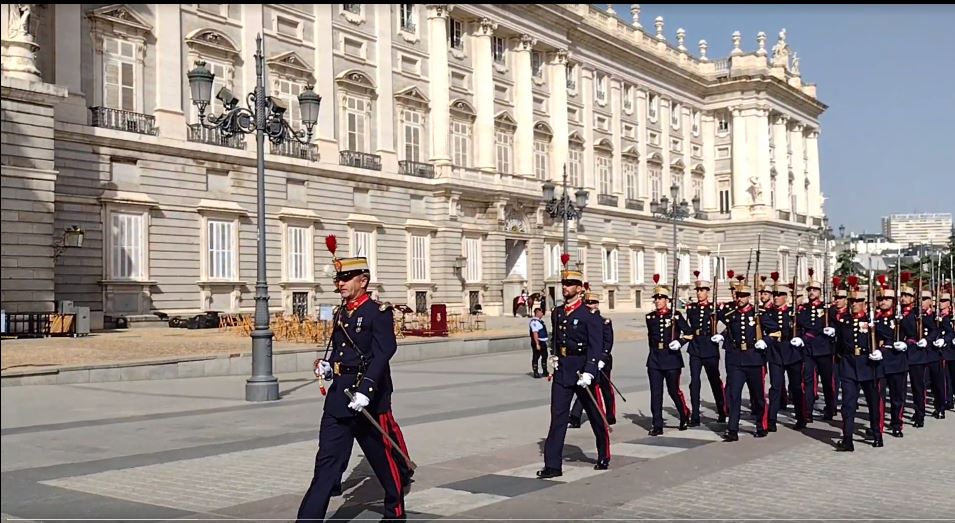
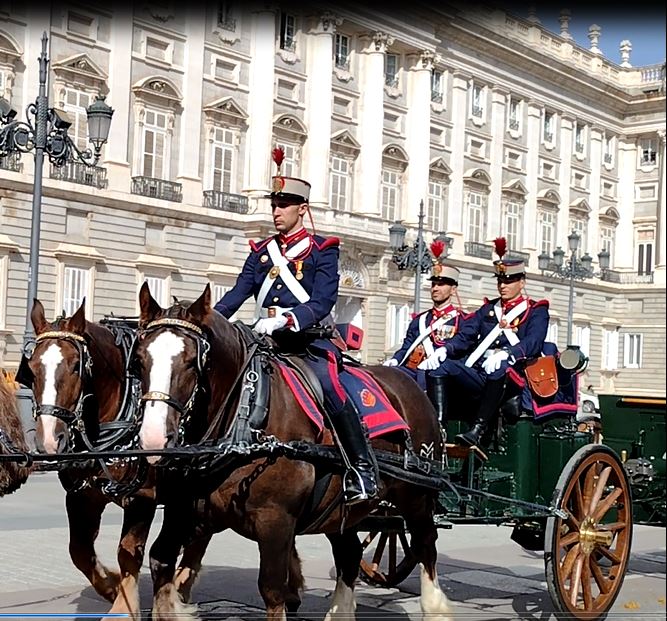
This may have been more than you care to know but I had to do something with all those photos! One more thing: Joe was responsible for our itinerary and ALL the driving. It was a wonderful trip, and a hell of an anniversary gift.
Sep 30, 2020
I am about as fortunate as one can be in these unfortunate times. I do not live alone, but with my husband and granddaughter, and we get along well. I have a garden, a swimming pool, the writing work I love, and no money worries. I don’t have a job that demands I spend most of my time virtually, nor small children whom I must help with virtual school. The only direct impacts I’ve suffered from Covid 19 are a minor one, being unable to dine out, and a major one, missing the annual gathering of family in Maine.

Blue glory vine. Image: purple trumpet flowers with yellow throats, swimming pool in background
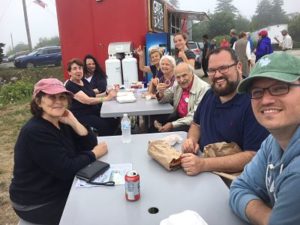
My family in Maine. Image: Nine smiling middle-aged and old people at picnic tables in front of lobster shack
Nevertheless, I get the blues. I feel dark clouds looming just behind me. I try not to spend all my time on them – I use an app to block social media for twenty four-hour stretches, don’t read news at the beginning or end of the day, listen to music more than to NPR.

Image: white butterfly logo on green background with message: You are free. Go do great things. website: freedom.to
But there is no app to suppress my thoughts, and other people’s troubles haunt me. The people who have lost their jobs, who will lose their homes. The kids who graduated from high school or college in the spring, into a world of few possibilities. The teachers, struggling to teach simultaneously in person and by Zoom, maligned in letters to the editor and on social media. All the essential workers, fearing for their health. The hospital workers fighting death daily. The people on ventilators, dying alone, and their families. Nursing home residents and prisoners.

Lowell Correctional Institution (in August, 900 of 2200 inmates tested positive). Image: cinderblock building with coiled razor wire.
And behind that cloud of sorrow is shame. After years of imperialism abroad and inequity at home, I didn’t think I had any patriotism left until we failed so miserably in this latest trouble. Our government is a terrifying disgrace.We have managed to turn public health into a divisive political issue, and we can’t even work out how to produce enough protective equipment. Every couple of weeks a cellphone records another murder of a Black person by a police officer, usually followed months later by a slap on the wrist, or less, for the killers. Above it all, a looming cloud of fear. What will happen in November? And what will happen in the months between the election and the inauguration?

image: sign “2020 Vote Election Day” blue and red letters, flag logo
Well into the summer I was faithful about routines. I worked out every other day, swam, weeded in the garden. I revised my novel twice at my publisher’s suggestion, wrote five chapters of another novel, sent a query to an agent, worked on my website. Mostly confined to my house, I almost achieved the productivity of a writers’ retreat. Then sometime in August my energy flagged. Now I have turned to music.

In my writer’s retreat. Image: white-haired author in bed under red blanket working at laptop, leaning on huge teddy bear with yellow rubber chicken dangling above
I have long been a fan of Black gospel, with its rocking rhythms, powerful harmonies and soaring solos. I listen to it on long car rides. When I work out I listen to gospel and sing along with any breath I have to spare. It’s not just the music; the words cut right to my heart. Some songs make me jubilant, others make me cry. An atheist, I’m not sure why gospel moves me so profoundly, but I think it’s the mixture of joy, sorrow and hope.
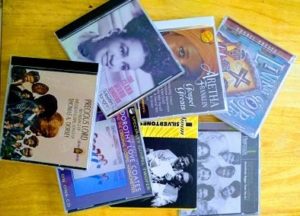
image: pile of CD’s: Clara Ward, 2 gospel compilations, Aretha, Silvertones, Dorothy Coates
Emily Dickinson called hope “the thing with feathers,” a bird that sings “sweetest in the Gale” and keeps us warm. I think we hold onto it even when we don’t believe. The darkest thing is despair. It leaves us unable to move, unable to act. Even delusional hope lets us move forward.

Despair. image: woman in jeans seated on floor against gray wall in empty room, knees drawn up, head rests on arms. Photo by pixabay at pexels.com – resized
Like gospel, classical choral music moves me deeply. I used to sing in large choruses. To hear many voices sing complex music is thrilling; to stand in the middle of the ocean of glorious sound and add your voice is sublime. In August I took an online course in choral repertoire that focused on requiems. I was already familiar with the Mozart; when the class was over I decided to study the Berlioz, Britten and Brahms.
I printed out the librettos with translations. It’s hard to follow along – unlike gospel, in classical works the music is more important than the words, and composers often stretch syllables over many measures. But reading the text gives me some sense of the meaning, and I’m slowly learning to recognize each movement.
The Mozart and Berlioz are based on the Roman Catholic mass for the dead. They focus on the Day of Judgment and the horrors of Hell. They plead for forgiveness and eternal rest. The Brahms uses biblical texts to offer consolation to mourners. It acknowledges grief, promises joy, and doesn’t get grisly about Hell. The Britten War Requiem mixes texts from the mass with bitter poetry by Wilfred Owen, killed in World War I at age 25.
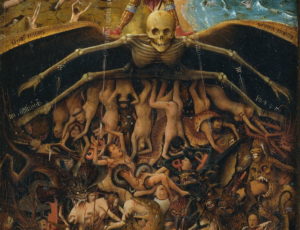
Two kinds of Hell. image: detail of The Last Judgment by Jan VanEyck – skull looms over naked tortured souls

Two kinds of Hell. image:black&white photo of WWI soldiers going over the top of trench in Battle of the Somme, 200,000 British soldiers were killed on the first day.
Recently I broke my cardinal rule, and read the New York Times first thing in the morning. It was truly disheartening, especially Thomas Edsall: “Five things Biden and his allies should worry about.“ I was already worrying about most of them. It made me angry, made me wonder whether the Rump has taken over everything, and has the Times helping him in his strategy of sowing chaos, confusion and fear.
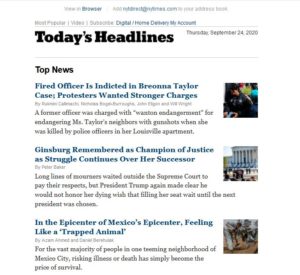
image: Sept 24 NY Times headlines re Breonna Taylor indictment, death of Justice Ginzburg, Covid 19 in Mexico,
So, after crushing myself with bad news, I turned on the gospel music. The Staples Singers told me “I know a place where aint nobody worried,” and promised “I’ll take you there.” The Mighty Clouds of Joy urged me to take a load off my mind and “Ride the Mighty Glory.” I danced, lifted weights, slam-balled, squatted. And when Shirley Caesar sang that great tearjerker for moms and grandmas, “No Charge,” I cried the tears that have been building for months. Then I jumped in the cold pool and sang, “High upon the mountain, leave my sorrows down below.”
It all energized me. I wrote for a couple of hours, then sent an email to the Democrats offering to volunteer. I weeded until I got too hot. I made a carrot cake as a treat for Joe the law teacher and Amanda the high school senior, who are both dealing with HyFlex – the unwieldy scheme for teaching students online and in person at the same time.
The War Requiem is next on my study agenda. When we studied it in class it sent me back to Pat Barker’s Regeneration trilogy, about the British psychiatrist in World War I who treats soldiers sent home with shellshock so that they can return to the trenches. I read the bitter war poetry of Owen and Siegfried Sassoon, both characters in Barker’s novels. Like the Britten, Barker’s trilogy is a brilliant anti-war work of art.
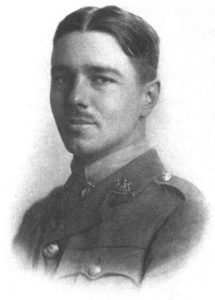
Wilfred Owen. Image: young man in soldier’s uniform with mustache and slicked down black hair parted in the middle
I learn most of my history from fiction. We’re living in a very hard time, but human history is filled with hard times, when fear, confusion and conflict reigned. Lies flew from all sides. People struggled to understand, to find meaning, to figure out what to do. There were many villains, but there were also heroes. My granddaughter asks me why I like to read about hard times, and I tell her it moves and inspires me to see how people survive and sometimes triumph over trouble. It gives me hope.

The thing with feathers. nimage: European robin, gray bird with rufous head and breast, singing on branch against gray sky. Photo: Pixabay at pexels.com
Sep 8, 2017

To my readers: This is my first post since January. Family troubles, including two serious illnesses and my sister's death, turned off all my writing except my diary for a while. I believe I'm back in business now.
Tuesday night I told Amanda I’d go to Walmart first thing Wednesday to prepare for Irma, the monster hurricane that might be heading our way. I told her not to tell Joe, since I was sure he would scoff. She didn’t tell Joe, simply asked me in his presence, “Did you tell Grandpa about Walmart?”
Joe didn’t scoff, exactly, just claimed that we weren’t going to lose power because we never have since the lines were buried underground. I pointed out that in 2004 power went out all over town despite the buried lines. (Gainesville doesn’t get the full force because we’re halfway between the Gulf and the Atlantic,60 miles from each of them. But this is a monster hurricane, extremely large, extremely fierce.)

image: weather.com
Though I’ve lived in Florida 43 years I’ve never prepared for a hurricane before. When I lived near the coast, in Jacksonville, I was a young single mother, and I would dither and fret as hurricanes threatened: I don’t know how to put up plywood, don’t have tape, what do I do, what do I do? As I look back I realize how very young I was, and how far I’ve come.
Five hurricanes hit Florida in the summer of 2004. Number two, Frances, was a mere tropical storm by the time it reached Gainesville, but some people lost power for two weeks. We only lost power for 45 minutes. We were in bed when our neighbor’s huge laurel oak, hollow inside, slammed down onto our roof, right over our heads. It took nine months to replace the roof and repair all the damage.

image:mldavisinsurance.com
Irma is coming at a particularly unfortunate time for the Muumuu Mamas. This weekend was going to be our annual beach expedition, eight of us together for three nights, with no responsibility for anyone but ourselves, all of us lovers of food, conversation, dancing, long walks on the beach, and each other. My sister Luli died just three weeks ago, and I needed comfort from those seven mamas, so when our beach weekend blew away, I was gloomy. But then the women came up with an alternate date in November, and Julie found us a house, so I’m feeling more cheerful. click


relaxing at the beach 2013
Just after 6:00 on Wednesday morning I headed to the nearby Walmart with a short list: water, tuna, soup, crackers, baked beans, pineapple, ravioli and smoked oysters (both favorites of Amanda). The parking lot was only a third full. The shelves were even emptier.

image:financialmoneytips.com
Going down the canned goods aisles was an interesting lesson in what people won’t eat, and what I’m willing to eat if desperate. All the tuna was gone, but there were plenty of water-packed scallops, clams, and oysters. Two cans of herring, two of smoked oysters – I took them all. The only baked beans left were vegetarian or ‘touch of maple.’ I took two of the latter, though now I’m having second thoughts.
All the soups were Campbell's. Cases and cases of cheese soup, and cream of mushroom, and a fair amount of broth. That was it, except for three four-packs of chicken noodle – I took one – and a few cans of Slow Kettle Style portobello mushroom-and-madeira bisque, and andouille sausage jambalaya with chicken and ham. How nasty do you suppose they’ll be? No ravioli, and I turned up my nose at the spaghetti-o’s. I got saltines and peanut butter crackers – the only peanut butter available was flavored, or swirled with jelly, and I just couldn’t.


Am I too fussy? images: target.com, reddit.com
Little snack packs of nutella for Amanda. Canned pineapple and canned corn – the only canned produce I can stomach. A jar of peanuts, a box of raisins, instant oatmeal. I asked a woman stocking the chips shelves where the bottled water was. She said there was none left at Walmart but they had pallets at the Publix at Hunter’s Crossing, which opened at 7.
I arrived at Publix at ten to seven. They had opened early; people were already leaving, with carts loaded with water. This was the on-their-way-to-work crowd. I took two 24-packs of pint bottles, though I hate buying plastic bottled water. But inside, in the water aisle, a man was just unloading pallets of gallon jugs. The Official Recommendation is a gallon per person per day for three days, so I took 8 gallons and returned one of the 24-packs.
Publix’ shelves were more generous than Walmart’s. I bought lots of tuna, four cans of Progresso soups, ravioli. In the ethnic aisle I considered a can of beans that contained blood sausage,chorizo and ham, but thought better of it. I love blood sausage, but in a can? I don't think so.

image: cubanfoodmarket.com
People who only bought water were in the ‘ten items or fewer” check-out lines. (I love that Publix’ sign-makers know the difference between less and fewer). Everyone else was in the regular lines, twenty or more people in each line, the lines stretching way down the aisles. I took an instant dislike to the man in front of me, and reached all sorts of unsupported conclusions about him. He muttered gloomily that there’s a thin line between humanity and chaos, and people shouldn’t panic. I was sure that in an emergency situation he would try to take charge, bossing everyone around, with no skills nor information.
There was no sign of either panic or chaos. Instead people were cheerful, saying how many families they were buying for, what happened to them in previous storms, claiming expertise because they’d lived in South Florida for years and were used to it. Somebody pointed out that after it was over we could always donate the water jugs to some other emergency down the road. There was a pleasant sense of community, and it cheered me up to be doing this, brought me out of the very inward state I’ve been in since Luli died.
At home I stored my supplies, and told the family we don’t TOUCH them unless the power goes out. For extra security I hid the oysters and nutella behind other cans. We can celebrate the end of hurricane season with a most peculiar feast, and donate the water bottles to the HOME Van.

I felt a proud sense of accomplishment as I looked at my tidy stash. And last night Joe, who has been following every detail of the forecasts, and analyzing how they are produced, said that he took back his mocking, and thought I had done an excellent job. It’s only Thursday, but Amanda's school has already cancelled Monday’s classes. Nothing is supposed to happen in Florida till Saturday morning, and north Florida doesn’t expect trouble till Sunday afternoon. The roads north will be godawful jammed, the gas stations are running out, the sky is gray. We’re waiting for Irma, who may not visit us. I hope she veers way east to the middle of the ocean, but if she hits us, I will eat weird soups, and enjoy NOT saying ‘I told you so.’
UPDATE: I’m posting this Friday morning. Gainesville is now smack in the center of the cone of uncertainty, and so am I, with a small nervous knot centered somewhere between my throat and my belly, and possible tension covering head to toe. My sense of humor may evacuate. I fret about all the possible horrors for everyone else, but for us I just focus my hopes on: Please no more trees on the roof.
Dec 11, 2015

Last spring I discovered MOOCs (Massive Online Open Courses), when my friend Sandra posted a notice on Facebook of a Stanford course, Ten Pre-Modern Poems by Women. My sister Luli and I both signed up.
The professor, Eavan Boland, is an Irish poet and professor of humanities and creative writing at Stanford.click She was aided and abetted by young poets in the creative writing program. After Boland talked a bit about the poet and her time, and described the poem, we read it and gave our first impressions. An illustrated lecture went more deeply into the poet’s life and times, and analyzed the poem. A contemporary poet commented on the poem, and then we had homework assignment. Faculty and students responded to each other in the discussion forum.
Some of the poems – Browning’s “How do I love thee?” and Rossetti’s “When I am dead, my dearest” were very familiar. I’d seen them so often that the words had lost their meaning. But doing the homework, and reading the faculty and students’ remarks, I saw them fresh.

“I love thee to the depth and breadth and height my soul can reach” Image: The Grand Canyon. National Park Service

“When I am dead, my dearest, Sing no sad songs for me; Plant thou no roses at my head…” image: Flickriver.com
I’d never heard of Anna Laetitia Barbauld, but I loved her poem, “Washing Day,” a picture of the weekly disruption in an 18th century English middle class family when the washer woman comes to do the laundry. It’s full of vivid scenes and pictures: the clotheslines break, the dog knocks over the drying rack. a little boy loses his shoe in the mud. We see the whole population of the household: the wife, husband, maids, children, grandmother, visitors. There are enough characters and action in Washing Day to make an amusing play, or if you are novelistically inclined there are plenty of scenes to get you started.

Laundry Day c.1765. Image: British Museum
For each week and poem there was a choice of three homework assignments, always including the opportunity to write a poem of your own. For me this was the easy way out. Rhyme and meter are in my blood – doggerel runs in my family. I can write a bad sonnet with the best (or worst) of them, but I soon found I focused more on the poem under discussion if I wrote one of the essays instead.
Rosetti’s poem came alive for me again when I went to YouTube and heard it set to music. I listened to three versions with different melodies and performers. The different songs transformed the poem into something new, and led me to examine the original more closely. click
I was enjoying this course so much that I signed up for another one, Harvard’s Poetry in America: the Civil War and its Aftermath. It had a great deal more material than the Stanford course, all of it tempting. It included a baritone singing Swing Low Sweet Chariot under a slide show of engravings and photos, a discussion of The Gettysburg Address, a Confederate nurse’s diary, and John McCain reciting The Cremation of Sam McGee, which he learned in Vietnam when the prisoner in the next cell tapped it out in code. I soon realized that if I added that course while continuing the Women Poets course I would be a full-time student. I don’t have time for that, so I stopped after a couple of weeks.

Union nurses in the Civil War. Image:civilwarsaga.com
I finished Ten Pre-Modern poems in June, and early in September I started taking Modern and Contemporary American Poetry from the University of Pennsylvania. Each poem was accompanied by a video discussion between the exceptionally good professor and his grad students, conducting close readings of all the poems – word by word and line by line, not neglecting punctuation and line breaks. There was a lot of additional material available, as well as very intelligent discussion on the forums. This was the best and most challenging of the three courses. I stuck with it for eight weeks, through the Beats, but with my Voices Rising concert and a trip to the Grand Canyon looming, and from sheer intellectual exhaustion, I stopped.

UPenn Prof. Al Filreis and grad student Anna Strong.. I loved watching these video discussions partly because Al reminded me so powerfully of my late friend Jim Hardy, down to his voice and the twinkle in his eye.
All the courses have participant discussion forums, and participants come from all over the world. I love hearing furriners talk about us, because it reminds me once again how very parochial we are. People from Peru or Pakistan aren’t necessarily affected by the American orthodoxy-of-the-week. In the Harvard course, several recommended Gone with the Wind as an excellent portrayal of the horrors of the Civil War.

image: ew.com
Most forum posts drew no response – I suppose we’re more interested in our own thoughts than in anyone else’s. In the Civil War poetry course, the longest thread by far was started by someone who asked people to share their creative work. The poetry poured in. None of it had anything to do with the Civil War.
Like any college student, I like to gripe. Judging by the professors in these courses, the current fashion in academia, perhaps stolen from literary fiction, is to discuss everything in the present tense. I hear journalists on NPR do this too.
I suppose somebody has decided that it brings history to life, but it annoys the hell out of me. Aside from impoverishing the language, it flattens our sense of history, and creates a false intimacy, a pretense that barriers of different world-views and culture don’t exist or don’t matter. It leads directly to our presuming to judge the outrages of other eras as though we sensitive souls of the 21st century occupy some moral high ground. I’m convinced that wickedness and cruelty, intolerance and exploitation, selfishness and greed continue in humankind at pretty much the same level through the ages. Only the victims and methods change.

image: thinglink.com

image: linkedin.com
The discussion in the women poets course frequently raised issues of class, race and gender. While I’ve been obsessed with these most of my life, I found myself impatient with what seemed to be requisite and rote comments. I finally wrote a waspish response in my essay about “Washing-Day,” which I generously share with you:
Yes, they hired laundresses, who doubtless had rough lives. Maids worked very hard and had little power or independence. The poet could have written about The Washer Woman, but on this occasion she chose to write about what it was like in the household on wash day. I see no need for 21st century readers to tut-tut about the evils of other historical periods – we have plenty of our own. If I read a contemporary poem about a young girl who is a gifted gymnast, I don’t feel impelled to discuss the sweatshops in which the beads were sewn onto her costume, unless the poet is implicitly leading me there.

Gabby Douglas. Image:usa.com
Aside from my quibbles with substance, I found the technology cumbersome. It took four tries to create a damn password for the Stanford course – with each try, they came up with a new rule: must have numbers, can’t use symbols, must be gluten-free.
 image:passwordmeter.com
image:passwordmeter.com

All my passwords are gluten free. image:fixyourdigestion.com
The Harvard course was worse. It ate my three paragraphs of delicious analysis TWICE. It buried all kinds of critical information several layers down in various links: there were eleven pages of FAQ, and then a separate FAQ thread in the discussion section. It took a lot of digging to discover that the course was designed for Chrome, and Firefox users (me) were particularly likely to have problems.
I recommended the course to Luli, but suggested she just read and view the materials rather than try to respond. She claims she once took a hammer to a recalcitrant computer, and the obstacles in this course were so frustrating that I was afraid she would blow up her whole office.

If I had a hammer… image:hongkiat.com
The Modern Poetry course, which Luli was very engaged with, refused to recognize her after a couple of weeks, and though she and I spent hours on the phone trying to fix the problem, she finally had to give up.
It was their loss. Luli’s participation in the Women Poets course had enriched it for me and many others. Thanks to a wild and crazy adolescence, she barely finished high school and never went to college. She’s as widely read and knowledgeable as anyone I know except our sister-in-law Doris, but she hangs out with a number of highly educated writers and librarians, and she thought it would be cool to have a certificate saying she completed a course at Stanford.

Luli got a certificate. Image:stolinsky.com
We enjoyed the course together by phone and email. Luli in academia is a little like Alice in Wonderland – she sees things for what they are, rather than accepting the strange transformations of truth that blossom in the groves of academe. For example, here was her response to my discussion of the You Tube performances of Rosetti’s poem:
cor blooming blimey! what a load! i listened to the ones you mention, plus a passel of others…not all the way through any of ’em, because i thought them all total rubbish. as maudlin as a bunch of drunks. which the poem isn’t. and so many overblown orchestral arrangements for this simple, tongue in cheek song. my god. but, i liked your essay.

A bunch of drunks. image:crujonessociety.com
For all my carping, I think MOOCs are great. However, be warned. Though all of the courses emphasize that you can participate as much or as little as you want, it’s hard to resist doing more than you have time for. It’s like spreading a buffet in front of a hungry person. The Ten Pre-Modern Poems course is the least demanding (after all, it’s only ten poems) and its approach, including the assignments, the least rigorous. But I enjoyed it, I learned a lot, and it didn’t eat up my life. The Civil War poetry course was rich with material, and I will probably return to it. Though I didn’t stick with it long, my impression is that their poetry analysis is more historical than literary. The Modern Poetry course felt like a graduate seminar in poetry – very intense, and very focused on the poetry. I gained new appreciation for Dickinson, Whitman, William Carlos Williams and Ginsberg, and met others I’d never heard of. I do intend to go back to it, though I’m a little daunted by the time required to do it well, and I may tire of the close reading approach.
Here’s a link to find MOOCs. click. Courses in subjects like engineering, computer science, and business far outnumber the arts and humanities. But their search engine is good, and if you’re so inclined you should be able to find the courses I’ve mentioned, as well as other humanities courses.
In the quest for eternal life and vigor, boomers are advised to keep exercising their brains along with their bodies. Eternal life doesn’t appeal to me, though vigor sounds nice, but I love reading poetry, and learning new stuff is fun.
.
May 7, 2015

Neophilia. The word was coined by my sister Luli. With two more letters it could be something rather ghastly, but as it stands it simply means loving novelty.
Every few years I discover a new creative passion. I pursue it with fervor, but never develop any great skill. I love learning something new, and I love producing a physical object. My work, whether lawyer or teacher or mother, always consisted primarily of ideas and people.

I like to create something concrete (or butter) source:iowastatefair.org
It began with crochet. When I was 28, my friend Saralu and I drove from Jacksonville to Lakeland for a cram course before the two-day nightmare that was the Florida bar exam. We had packed frozen soups,stews, and a crockpot, cheese and fruit, cookies and wine.
The cram course consisted of long lectures and written summaries of the entire body of common and Florida law, each subject – torts, contracts, trusts and estates, etc, crammed in a tiny font on both sides of laminated pages. They were dense as a Claxton fruit cake, though less digestible. Every evening we returned to our motel room with heads buzzing – fee simple with remainder, statute of frauds, the mailbox rule, equitable estoppel.
After supper we poured wine, opened the cookies and sat on our beds, diligently memorizing the incomprehensible for about fifteen minutes.Then Sara unpacked her yarn and taught me to crochet. In three nights I had made half a shawl. In the next few months I had made shawls for my friend Sue, my sister Luli, and both my sisters-in law. That took care of Christmas.

For several years I entertained myself with yarn. I made a sweater for my son in brown, black and rust. He was five, young enough that he didn’t mind wearing it. I made a couple of lace shawls in a fan pattern. I invented my own granny square, a sunburst in brown, beige and yellow, and made an afghan for my boyfriend. Unfortunately I joined colors by simply weaving them in, as recommended by the crochet book, rather than knotting them. In a few years, the whole huge thing was beginning to unravel. Then I tried my hand at knitting. I bought expensive wool in lavender, pale pink, and deep cherry red, and made the front and back of a gorgeous sweater. Alas, I lost interest before I got to the sleeves, and I never finished it.
I took drawing classes. I learned to stare and stare, looking for lines and shapes and shifting shades of color. I drew a pair of shoes, a paper bag, and my masterpiece, a pair of hands holding a baby’s tiny feet, drawn from a photograph. I spent hours on Sunday afternoons, totally absorbed, leaning over the table, focusing so intently the sweat rolled down my face. I did lightning sketches at a Saturday morning drawing group, where $5 bought a couple of hours with a model. I carried a small sketchbook everywhere. I drew people in airports and animals in Africa. I realized that drawing from photos was easiest – the image already reduced to two dimensions – so I drew many earnest talking heads on McNeil-Lehrer.
I enjoyed the sketches, but it took hours to draw a full picture. I searched my craft closet while I wrote this post, and found the big brown portfolio from my drawing class. The pictures were dated March and April, 2002, before Amanda was born. Even though she usually lived with her mother in the early years, big blocks of empty time became less available after Amanda.
I gave up copying the world and began doodling my inner visions with colored markers. This was great fun, frequently fueled by marijuana. It resulted in many strange images on greeting card stock, often phallic or uterine or both. My all-time favorite is an anxious-looking multicolored bird pursued by little turd-y haystacks, a perfect depiction of aspects of my life.



I took another class, and discovered the joy of collage. For eight weeks I worked on a huge naked goddess, with flames for hair and a rainbow of flowers above her head. The crowning touch was interchangeable merkins* in different colors – thread tangled up and stiffened with glue, attached to her mons veneris with velcro.
She has been in the closet for many years, and when I took her out I still loved the suggestion of musculature in her disproportionate limbs. I could only find one merkin, a purple one that has faded to a boring brown. I don’t want her anymore, and I was planning to throw her away if I could figure out how to put her out by the curb without horrifying the neighbors. But Luli begged me to send her to North Carolina. So I shall veil her in newspaper and take her to Fed Ex. It will be Luli’s last 70th birthday gift.

Goddess of Flowers and Fire
After this tremendous project my ambition shrank to a more manageable size and I began making greeting cards. Collage is very slow, or maybe I am very slow, and a single greeting card takes me several hours.
I love my collaged cards so much that I can’t bear to send them away; I have several waiting for an occasion worthy of their splendor. However, I did send one to Michelle Obama. It was a strange-looking woman, rather fat, resplendently attired with a belt and brooch, wielding a peppermint-striped cane. I wrote a gushing message expressing my great admiration, told her the card was inspired by her fashion sense (belt and brooch), suggested that Malia and Sasha might enjoy guessing the source of each scrap in the picture, and enclosed an answer key. I received no reply, nor did the Secret Service pay a call.
I made the card for Mrs. Obama when I was recuperating from my second knee replacement, shortly after Obama’s first inauguration. Recuperation entails a lot of time on the sofa, painful physical therapy, and frequent hydrocodone. Most of my creative work is not inspired by drugs, but when it is, it is truly…inspired.
I




Painting T-shirts was my passion for a while. I made one with hippos for my brother-in-law’s fortieth birthday. I made two with large birds, one nibbling strawberries from the crew neck, the other with baby birds peeping from the pocket. These were for my older brother Don and his wife Doris, who wore them all over China, looking very pleased and completely ridiculous. I drew a strange grinning face in black marker on a gray shirt for Luli. I liked it so much that I made one for myself in color labeled, “Grandma.” I used the same design on a dress for 3-year-old Amanda, with the caption: “I’m with Grandma.” It helped people match black toddler and white guardian, prevented them from saying, “Where’s your mother,” at playgrounds.




I have recently returned to crochet, and made about nine hats for homeless people. Several groups of women in Gainesville make hats for the homeless, and the HOME Van used to display them on a clothesline in the trunk of Nancy’s car – a wonderful assortment of styles and colors, all hand-crafted. It was a treat to see people shopping for their favorite, and an even bigger treat when somebody chose one of mine. Now that HOME Van driveouts are, alas, no more, I can donate my hats to the clothes closet at Grace Marketplace, which Nancy and her pals have set up as an elegant boutique.

Hats and stole (to keep the Feminist Grandma warm as she works)
To my surprise, digging into my craft closet to find my old work depressed me. I had been celebrating creative play. Now I was surrounded by abandoned pursuits, and suddenly Oughts and Shoulds and You Never Stick to Anything echoed around me. Apparently I’m not good enough unless I’m a great writer, drawer, singer, crocheter, and shoe and fabric painter. Perhaps I wouldn’t mind this nagging work ethic so much if it resulted in great achievement.

Every dabbler needs a craft closet
I am not worthy of the name of amateur. An amateur is one who loves passionately, who devotes herself to her art or craft. I am a dilletante, a dabbler. I have many brief, passionate romances, like a bee going from flower to flower, producing mongrel honey.
But damn it, I’m retired. Why can’t I just have fun? Consider the lilies of the field. Why should I have to toil and spin all my waking hours? I don’t suppose my goofy painted shoes click and t-shirts are quite as splendid as good old Solomon’s array, but they please me. Someday I may be sufficiently sane to acknowledge that is enough.
* Merkin: artificial pubic hair. “According to “The Oxford Companion to the Body,” the custom of wearing merkins dates from mid-15c., was associated with prostitutes, and was to disguise a want of pubic hair, shaved off either to exterminate body lice or evidence of venereal disease.” source: Dictionary.com
Apr 26, 2014

All my life I have loved to sing. Family gatherings always included singing, with my brother Dickie playing the guitar. On long car trips, in between territorial squabbles, Luli and I harmonized in the back seat. I was in the chorus in high school, and the Jacksonville Concert Chorale when I was a young lawyer.
I sing in the shower. I sing while I’m cooking, cleaning, gardening or driving. But constant song annoys those of us who like to be lost in thought; Joe sometimes and Amanda always asks me to shut up. I comply, though losing my singer makes me sad, and I sometimes resent being silenced, so I decided to take singing lessons and join a chorus.

singing in the kitchen image:ubergizmo.com
In February I went to the United Church of Gainesville’s women’s retreat. This is one of my favorite annual events. I like the women I’ve met at the church, and there are interesting workshops, religious, spiritual, artistic, or goofy. The setting is lovely, overlooking a marshy lake. And the best part is I have two days and a night on my own, with a room all to myself.

image:madisonfl.org
At this year’s retreat I met Rebecca Pethes, a young woman whose rippling curls and liquid voice are bright and warm as a new penny, and who teaches voice at Gainesville Guitar Academy. We instantly hit it off.

click
Then I attended a workshop, “Sound bodies, the first musical instruments,” where we made as many sounds as we could with our voices and bodies – rattling our tongues, popping our cheeks, howling, stomping, clapping, slapping and finally singing. After the workshop Jan Tucci invited me to join Voices Rising Community Chorus, an intergenerational group of singers who perform a wide range of music in two concerts a year.

Director Ruth Lewis and the chorus. image: Senior Times click
Now every Monday I have a singing lesson. I told Rebecca I wanted to lengthen my breath, strengthen my high voice, and learn to sing softly. We started with one of my favorite songs, John Prine’s Angel from Montgomery, and I began to practice stretching out my vowels and making my consonants quick and crisp. When we had wrung most of the learning out of that, she gave me Caro Mio Ben, an 18th Century Italian song with a simple romantic melody and melodramatic lyrics, full of cruel lovers, languishing hearts and endless sighs. I love it. We’ve been working on it about four weeks, and I am learning to let the air just fall into my lungs even when I want to gasp for breath, to let it flow out again over my vocal cords without straining. I’m finding a balance between my chest voice and my nasal voice.

image: 18thcenturycommon.org
Sunday nights I sing with Voices Rising under the direction of Ruth Lewis, an enthusiastic and exciting conductor. I have always loved classical choral music. In boarding school we trooped up the hill to sing Vivaldi’s Gloria with the neighboring boys school, including the trumpet-filled chamber orchestra, and I was hooked. In Jacksonville we sang Mozart’s Requiem, with the thundering Dies Irae. Now I play it on my stereo at full volume. We sang a concert version of Verdi’s Aida, with four excellent soloists but alas, no elephants. I still thrill at the name of Aida’s lover Radames.

Radames and Aida. image: arovingpittsburgher.blogspot.com
The repertoire for our upcoming concert includes only one classical piece, Sicut Cervus by Palestrina. The other pieces cover a wide range – folk songs, popular songs, and a show tune. At first I pooh-poohed eighty voices singing these simple melodies, but I’ve come to enjoy them. And we also get to sing a complex arrangement of the gospel Walk in Jerusalem, a deliciously woeful contemporary piece, Lamentations of Jeremiah, and the thrilling Pan-African national anthem, Nkosi Sikelela.

Michelangelo’s Jeremiah. image:commons.wikimedia.org

image: tvtropes.org
Amanda is galloping furiously into adolescence, with me and Joe barely holding on.When I practice my singing, when I’m thinking about my throat and breath and lips and tongue, about the pitch and rhythm of the notes, I forget everything else. When I’m singing with the chorus, surrounded by a great ocean of music, my life disappears. For an hour on Monday and two hours on Sunday night, and in my daily practice sessions, I take a vacation from my troubles. I believe in music. Singing brings me joy.









 (image by Joe)
(image by Joe)













 (images from pinterest.com)
(images from pinterest.com)



 (image pinterest.es)
(image pinterest.es)



 (image pinterest.es)
(image pinterest.es)


















